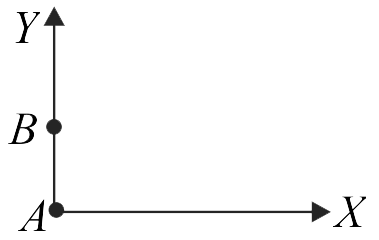367796
Two coherent light sources \({A}\) and \({B}\) are at a distance \(3 \lambda\) from each other \((\lambda=\) wavelength \()\). The distance from \({A}\) on the \(+{X}\)-axis at which the first constructive interference is found to be \({N} \lambda\). What is the value of \({N}\) ?
367798
Two beams of light having intensities \(I\) and \(4I\) interfere to produce a fringe pattern on a screen.
The phase difference between the beams is \(\frac{\pi }{2}\) at point \(A\) and \(\pi \) at point \(B\). Then the difference between the resulting intensities at \(A\) and \(B\) is
367796
Two coherent light sources \({A}\) and \({B}\) are at a distance \(3 \lambda\) from each other \((\lambda=\) wavelength \()\). The distance from \({A}\) on the \(+{X}\)-axis at which the first constructive interference is found to be \({N} \lambda\). What is the value of \({N}\) ?
367798
Two beams of light having intensities \(I\) and \(4I\) interfere to produce a fringe pattern on a screen.
The phase difference between the beams is \(\frac{\pi }{2}\) at point \(A\) and \(\pi \) at point \(B\). Then the difference between the resulting intensities at \(A\) and \(B\) is
367796
Two coherent light sources \({A}\) and \({B}\) are at a distance \(3 \lambda\) from each other \((\lambda=\) wavelength \()\). The distance from \({A}\) on the \(+{X}\)-axis at which the first constructive interference is found to be \({N} \lambda\). What is the value of \({N}\) ?
367798
Two beams of light having intensities \(I\) and \(4I\) interfere to produce a fringe pattern on a screen.
The phase difference between the beams is \(\frac{\pi }{2}\) at point \(A\) and \(\pi \) at point \(B\). Then the difference between the resulting intensities at \(A\) and \(B\) is
367796
Two coherent light sources \({A}\) and \({B}\) are at a distance \(3 \lambda\) from each other \((\lambda=\) wavelength \()\). The distance from \({A}\) on the \(+{X}\)-axis at which the first constructive interference is found to be \({N} \lambda\). What is the value of \({N}\) ?
367798
Two beams of light having intensities \(I\) and \(4I\) interfere to produce a fringe pattern on a screen.
The phase difference between the beams is \(\frac{\pi }{2}\) at point \(A\) and \(\pi \) at point \(B\). Then the difference between the resulting intensities at \(A\) and \(B\) is
367796
Two coherent light sources \({A}\) and \({B}\) are at a distance \(3 \lambda\) from each other \((\lambda=\) wavelength \()\). The distance from \({A}\) on the \(+{X}\)-axis at which the first constructive interference is found to be \({N} \lambda\). What is the value of \({N}\) ?
367798
Two beams of light having intensities \(I\) and \(4I\) interfere to produce a fringe pattern on a screen.
The phase difference between the beams is \(\frac{\pi }{2}\) at point \(A\) and \(\pi \) at point \(B\). Then the difference between the resulting intensities at \(A\) and \(B\) is

